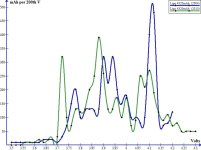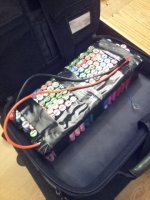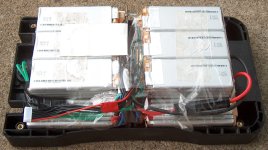DrkAngel
1 GW
2004 vs 2010 Laptop Lipo
Capacity mapped 2004, 2006, 2008 and 2010 2160mAh cells.
2004 and 2006 are very similar, 2008 and 2010 are likewise very similar.
While very similar to the 2004 and 2006 productions, 2008 and 2010 productions have clearly defined differences.
Most notable is a shift in capacity bulges.
2004 vs 2010 comparison

Capacity bulges demonstrate a clear and universal .05V shift towards lower voltage.
This is likely due to some "formula" modification.
Surprisingly, all formulations still exhibit 4.02V and 4.15V as their optimal charge voltages.
4.02V as optimal for best longevity ~400% cycle life. (at a 20-25% capacity loss)
and
4.15V as optimal for most efficient capacity ... with a reasonable increase, ~150%(?) cycle life.
Max DOD has been shifted from >3.75V to >3.70V
Notes:
The 2004 capacity increase at 4.20V (Blue line) is a flaw due to unattended "final" set and forget charge.
Performed test from 3.50V to 4.30V, below and above any expected reasonable capacity, I felt it responsible to be thorough ... and check for the unexpected ... no surprises tho ...
See - Capacity Mapping (Optimal Charge-Discharge Voltages)
Capacity mapped 2004, 2006, 2008 and 2010 2160mAh cells.
2004 and 2006 are very similar, 2008 and 2010 are likewise very similar.
While very similar to the 2004 and 2006 productions, 2008 and 2010 productions have clearly defined differences.
Most notable is a shift in capacity bulges.
2004 vs 2010 comparison

Capacity bulges demonstrate a clear and universal .05V shift towards lower voltage.
This is likely due to some "formula" modification.
Surprisingly, all formulations still exhibit 4.02V and 4.15V as their optimal charge voltages.
4.02V as optimal for best longevity ~400% cycle life. (at a 20-25% capacity loss)
and
4.15V as optimal for most efficient capacity ... with a reasonable increase, ~150%(?) cycle life.
Max DOD has been shifted from >3.75V to >3.70V
Notes:
The 2004 capacity increase at 4.20V (Blue line) is a flaw due to unattended "final" set and forget charge.
Performed test from 3.50V to 4.30V, below and above any expected reasonable capacity, I felt it responsible to be thorough ... and check for the unexpected ... no surprises tho ...
See - Capacity Mapping (Optimal Charge-Discharge Voltages)






